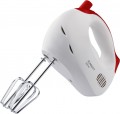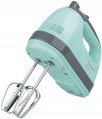Power
The rated power of the device, in fact, is the power of the engine installed in it.
The higher this indicator, the more performant this model is, the more suitable for “heavy” work and the more applications can be provided in the design. For example, in the case of mixers (see “Appliance type”), a power of up to 250 W is considered good for liquid products; for more solid tasks, like kneading tough dough, you should pay attention to more powerful models. Detailed recommendations on optimal power can be found in special sources.
Note that powerful devices are usually equipped with more durable nozzles that can withstand high loads.
Number of speeds
The number of speeds of rotation of the nozzles provided in the mixer / blender.
The presence of several speeds allows you to adjust the operating mode of the device to a particular situation. For example, a liquid omelet can be whipped at high speed, but it is better to choose a slower mode for kneading dough. The more speeds provided in the device, the more versatile it is, the more accurately it can be configured for a specific task. In simple household models, from 3 to 6 settings are usually provided, in the most advanced devices their number can reach two dozen.
Section / stand for attachments
The presence of a separate
section in the body for storing removable nozzles. Such mixers are convenient in storage, due to they are less bulky, take up less space, and the risk of losing any nozzle is reduced.

